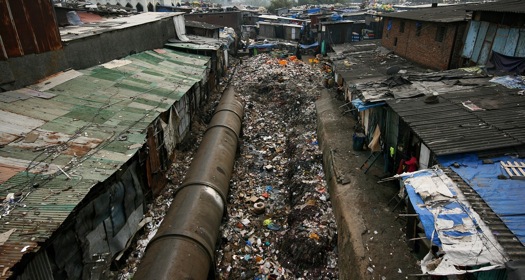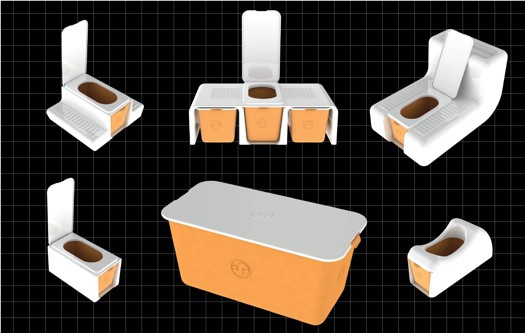
Inadequate sanitation bedevils slums such as Dharavi in Mumbai, India. Photo courtesy San+Co.
India has one of the world’s fastest growing economies and an emergent middle class, but an estimated 37 percent of the country’s 1 billion population still live in poverty and lack basic infrastructure. This disconnect is most evident when looking at popular products and services: there are more cell phones in use in India (about 700 million) than toilets (around 600 million), while 400 million lack access to electricity. Swapnil Chaturvedi, who was born and raised in India before going to the U.S. a decade ago to study mechanical engineering and design management at Northwestern University, wants to change that equation with a social enterprise he founded called San + Co. The idea is to create a closed loop system that provides a sustainable sanitation solution and, at the same time, off-grid electricity to homes. In India, Chaturvedi observes, “People will pay for what they want, like a cell phone, but not for something they need, like a toilet, so our business model is based on making sanitation an aspiration.”
The project, which recently won first prize at KIN Global, the annual conference of Northwestern University’s Kellogg Innovation Network, is based on the idea that India’s urban slum dwellers, who earn between $2 and $5 a day, would be willing to pay an estimated $6 to $7 a month for a system that provides a toilet and electricity for an entire family. The process starts with a specially designed toilet for the home, alleviating the usual ritual of defecating in the street or walking long distances and paying to use a public toilet. People known as scavengers, for whom the caste system allows only menial jobs, will collect the waste containers and receive a uniform, a salary and protective apparel, providing them with steady work and income and expanding the social aspect of the project. Then the waste is taken to a biogas facility for conversion to fertilize to be sold to farmers — a major source of revenue for San+Co — and to biogas to charge batteries that are then returned to the homes to provide electricity.

Different San+Co commode designs incorporate a covered container for transporting waste to a biogas facility.
After an initial pilot program in Raipur and further research, a number of changes and modifications are being made. The toilet was redesigned to accommodate the squatting position, which is common in India, and sitting, for older people. The team also realized that an aggressive educational plan was also needed to teach people about sanitation. Moreover, social recognition is being integrated into the marketing strategy: those who have a San+Co system can display a special decal on their homes saying they are now the proud owners of a toilet and a battery.
With $40,000 in prize money, San+Co wants to resolve several issues before a second pilot begins. One is another toilet redesign – with help from the nonprofit design firm Catapult in San Francisco — to deal with the smell from the waste container, which can be unbearable in the extreme heat common in India. Reliable partners with enough capacity must also be found for the biogas conversion and electricity distribution. If it works, San+Co will be able to provide sanitary facilities, improve health and bring electricity to homes that are either dark or lit by dangerous kerosene. But first, Chaturvedi acknowledges, “we have to make toilets as sexy as cell phones.”


Comments [7]
06.22.11
04:40
http://ghanasan.wordpress.com/
Also, I have seen presentations from the Environmental Sanitation Institute (ESI) in Ahmedabad that may suggest caution for this business model. I am sure that the disposal of the feces in this model is hygienic, but if not handled correctly, it has the potential to be very demeaning for those involved in this labor. More here:
http://www.esi.org.in/about_history.htm
Best of Luck!
06.22.11
02:27
I am very aware of the Project by IDEO/Unilever in Ghana. There are only so many ways value can be extracted from waste - namely fertilizer and energy. And that is why, at first glance, both models might look similar. But IDEO's model is NOT as closed loop as San + Co Model described above. They do not have provision for providing electricity back to homes.
Moreover, San+Co model also takes cultural issues of India into account, which are very different than cultural systems in Ghana. And if you look into IDEO's model, their service costs $10/month just for toilets. Whereas San + Co service provides both sanitation and electricity for $7/month.
I think this is quite a disruptive model. But they still have a lot of work ahead - mafia, corruption, government etc. Aligning incentives would be a great challenge that they will have to overcome to make this work.
Good Luck !
06.22.11
02:50
06.22.11
03:14
Thank you for your comments regarding IDEO Project.
We have had discussions with IDEO Designers working on the Ghana Project and have taken a lot of inspirations from IDEO and other Sanitation Business Models.
And thank you for your comments about safety and ESI.
If you go to http://san-and-co.com/inspirations, you will find that Ishwar Kaka and Dr. Bindheswar Pathak are our biggest inspirations. In fact, San+Co has the same mission as ESI and Sulabh.
----------------------------------------------------------------------
Suresh,
Thank you for your kind comments.
In my opinion, what differs San + Co from the IDEO project in Ghana are the "Design Insights" and the resulting synthesis. As you have mentioned, cultural systems and mental models (that people have) in India and Ghana are quite different. And as such our Models, Pricing and Go-To Market Strategy are different.
But in the end, we are all trying to bring "Design Thinking" to Sanitation. And for developing business models we also have to take into account the feasibility of Implementation. And that is why IDEO and San+Co might differ in the way they close the "loop".
I am glad that this article bring attention to Sanitation and associated societal issues.
Regards
Swapnil
06.22.11
07:09
For most of history sanitation has been a basic civic right and reality and cities just built sewers. No one grew up to aspire to having a toilet; codes demanded them and builders and the city just built them.
So, history's idea is to mandate and build septic; and this new idea is to create demand.
I tend to think in the case of 300 million poor in India you need something more like martial law - to protect and provide clean water and basic sanitation. Or maybe a blend of the two: civic intervention and design. I hope it works!
06.24.11
08:24
09.01.13
10:31